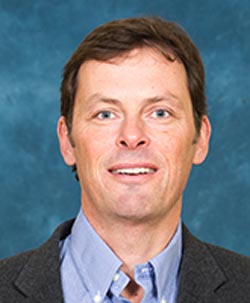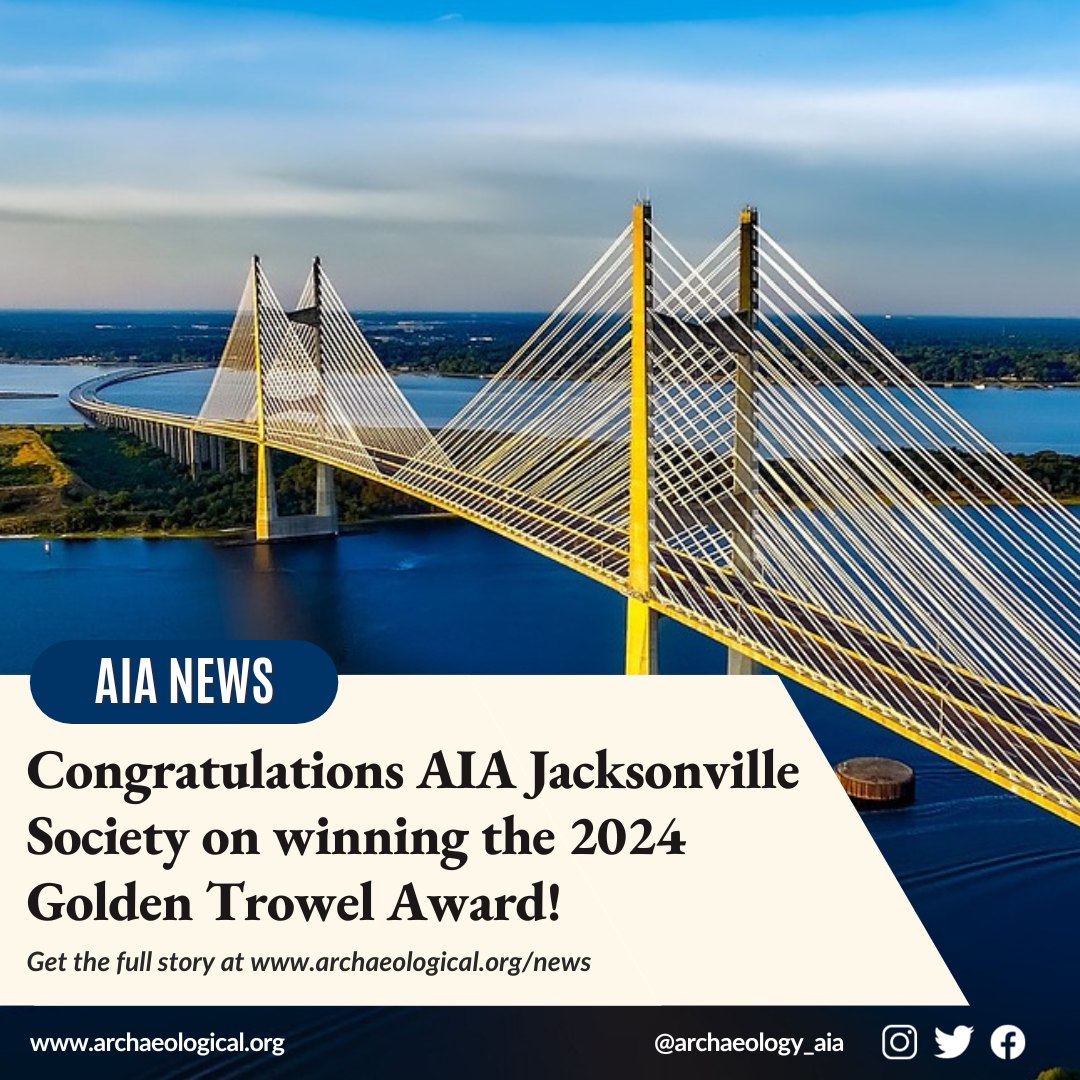The Archaeological Institute of America - Jacksonville Society
The Archaeological Institute of America (AIA) is the world's oldest and largest archaeological organization. The AIA is a nonprofit founded in 1879 and chartered by the United States Congress in 1906. There are more than 100 local societies, like this Jacksonville Society, in the United States, Canada, and overseas. Members include professional archaeologists, students, and enthusiasts, all united by their passion for archaeology and its role in furthering human knowledge.
The AIA promotes archaeological inquiry and public understanding of the material record of the human past to foster an appreciation of diverse cultures and our shared humanity.
The AIA supports archaeologists, their research and its dissemination, and the ethical practice of archaeology.
The AIA educates people of all ages about the significance of archaeological discovery and advocates for the preservation of the world’s archaeological heritage.
Professional archaeologists who are AIA members, have conducted fieldwork worldwide. The Institute has founded research centers and schools in seven countries and maintains close contact with these institutions. AIA Members are dedicated to the greater understanding of archaeology, the protection and preservation of the world's archaeological resources, and the support of archaeological research and publication.
SEASONAL LECTURES
PRESENTATIONS TAKE PLACE AT NOON EST, in Building 51 at the University of North Florida, Jacksonville, (1 UNF Dr, Jacksonville, FL 32224) UNLESS OTHERWISE NOTED. Email aiajaxsoc@gmail.com to find out if Zoom is offered for each lecture. The lectures are free and open to the public. After the lecture, complimentary refreshments may be served in the Physical Anthropology Lab. On Saturdays, parking is free and the staff/faculty/vendor spaces are open to everyone.
2025 MEETINGS & PRESENTATIONS
Our presentations are on summer break.
Join us in September for our fall series of fascinating speakers.

Dr. Geoff Emberling, the AIA’s Joukowsky Lecturer for 2025
Kush and the Roman World: Warrior Queens along the Nile
Ancient Kush was one of the earliest and longest-lived empires in Africa, rivalled only by Egypt. We think of Kush in terms of its relationship to Egypt of the pharaohs, but in fact Kush remained in power long after the last Egyptian pharaoh and indeed was rival and trade partner of ancient Rome after the Roman conquest of Egypt in 31 BCE. The initial contact with Rome resulted in a series of skirmishes in which the Kushite army was led in battle by a ruling queen or kandaka, who one Roman source described as “a masculine sort of woman who was blind in one eye.” The kandakas were part of a long line of powerful Kushite royal women, and they remain important symbols even in Muslim Sudan. This talk describes the long relationship between Kush and the Roman world, including espionage, conflict, and a long and rich trade and gift exchange.
Dr. Geoff Emberling is an Associate Research Scientist working at the Kelsey Museum of Archaeology, University of Michigan. He holds his degrees from the University of Michigan (Ph.D.) and Harvard University, and his research interests include the ancient Middle East (Mesopotamia) and ancient North Africa (Nubia and Kush), particularly early states, cities, and empires, ethnicity and identity, heritage, and collaborative community archaeology. Since 2012 he has co-directed archaeological projects at El-Kurru and Jebel Barkal in northern Sudan.
Dr. Jessi Halligan from Texas A&M University
Why underwater? The importance of submerged landscape research for understanding Pleistocene peoples in the New World
Perhaps most people think of shipwrecks when underwater archaeology is mentioned, but numerous formerly-terrestrial sites have survived drowning in our freshwater lakes and rivers and on our continental shelves. These sites can even be better preserved than their dry counterparts, and in some cases they can help us answer some of the most pressing questions about people in the past. Thousands of Pleistocene artifacts have been discovered in Florida’s rivers and springs, along with some of the best preserved early sites in the Americas. These sites are challenging archaeological models for the peopling of the Americas and are providing us with information about the lifeways of early Indigenous peoples in the New World.
Dr. Jessi J. Halligan is the Associate Director of the Center, an Associate Professor of Anthropology, and holds the Chair in First American Studies. She arrived at the Center in January 2024 from Florida State University. She specializes in the archaeology of drowned landscapes and the initial peopling of the Americas during the end of the Pleistocene. She currently is directing projects on late Pleistocene and early Holocene archaeological sites in the Aucilla River Basin in northwestern Florida, co-directing a submerged landscape survey in Lake Erie, and co-directing a collaborative project with the Bureau of Ocean and Energy Management to revise the Gulf of Mexico submerged pre-Contact archaeological survey guidelines. She has more than 30 years of professional archaeology experience, having directed projects on the Great Plains, the Midwest, Texas, and the Northeastern US, in addition to her current research in the Gulf region and the Great Lakes.
Dr. Andrea Torvinen,
Collections Manager of the Florida Archaeology and Ceramic Technology Laboratory at the Florida Museum of Natural History/UF
The Role of Collective Action in Community Resilience in Northwest Mexico
Dating to the Epiclassic period (600-900 CE), La Quemada, Zacatecas, Mexico, was founded during the cultural florescence of the northern frontier of Mesoamerica, but the site was abandoned ca. 800-900 CE while neighboring hilltop centers persisted. Having previously ruled out climate change as a contributing factor to the site's decline, this research investigates whether internal social unrest or shifting political or economic networks may have played a role. Specifically, did a change in how the occupants of La Quemada identified with one another decrease the potential for collective action over time? Material proxies in the form of ceramic styles (i.e., decoration or vessel forms) and fabric classes (i.e., petrographic and chemical data) are used to assess the temporal and spatial consistency of social identification at multiple socio-spatial scales within the site of La Quemada. Despite fluctuations, there was a high potential for collective action preceding site abandonment, suggesting that a disruption in the social fabric of La Quemada did not contribute to its decline. Therefore, being cut off from social networks developing between West and Central Mexico likely impacted the long-term resilience of La Quemada.
Andrea is an anthropological archaeologist interested in community resilience and social identity, compositional and technological ceramic analysis, and collective action among middle-range societies. Her primary research areas are West Mexico and the U.S. Southwest but she has also engaged in fieldwork in northern Iceland and west-central Illinois.
Dr. Daniel Pullen from Florida State University
A Late Bronze Age “Naval Station” at Kalamianos (Saronic Gulf), Greece?
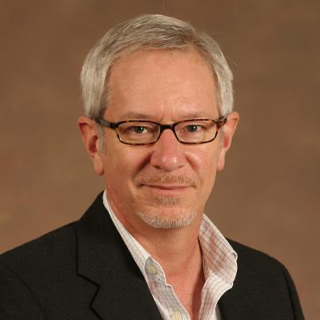 The Saronic Harbors Archaeological Research Project has documented the Late Bronze Age (14th-13th cent. BCE) harbor town at Kalamianos on the Saronic Gulf coast of the Corinthia, Greece. We suggest this site might be the Homeric town of “Eïones” which later Strabo identified as a “naval station.” The implications of this identification of Kalamianos as a naval station are evaluated in light of our current understanding of the archaeology of maritime culture, both commercial and military, of the Mycenaeans and other Late Bronze Age (LBA) peoples of the Aegean. The lack of identifiable maritime infrastructure – let alone that for specialized military activity – outside of Crete, including at Kalamianos, suggests that such installations were not essential for LBA maritime activities elsewhere in the Aegean.
The Saronic Harbors Archaeological Research Project has documented the Late Bronze Age (14th-13th cent. BCE) harbor town at Kalamianos on the Saronic Gulf coast of the Corinthia, Greece. We suggest this site might be the Homeric town of “Eïones” which later Strabo identified as a “naval station.” The implications of this identification of Kalamianos as a naval station are evaluated in light of our current understanding of the archaeology of maritime culture, both commercial and military, of the Mycenaeans and other Late Bronze Age (LBA) peoples of the Aegean. The lack of identifiable maritime infrastructure – let alone that for specialized military activity – outside of Crete, including at Kalamianos, suggests that such installations were not essential for LBA maritime activities elsewhere in the Aegean.
Professor Pullen is an archaeologist with training in Anthropology and Classical Archaeology, working in the prehistoric Aegean region, especially the later Neolithic–Early Bronze Age and the Mycenaean/Late Bronze Age. His research interests lie in the emergence of complex societies (the state and political economy) as seen through changes in regional settlement patterns, monumental architecture, and political economy and administration; landscape archaeology; the interaction of coastal settlements with maritime and landbound areas; and agriculture in ancient societies. His current research projects include the Late Bronze Age (Mycenaean) harbor settlement at Kalamianos on the Saronic Gulf of southern Greece; the Final Neolithic period at Alepotrypa Cave in the Mani of southern Greece; and the Early Bronze Age in western Anatolia, especially around the ancient city of Sardis. His major publications include the co-authored Artifact and Assemblage: The Finds from the Southern Argolid Survey (Stanford 1995), The Early Bronze Age Village on Tsoungiza Hill (Nemea Valley Archaeological Project I) (American School of Classical Studies at Athens 2011), the edited volume Political Economies of the Aegean Bronze Age (Oxbow 2010) from one of the department's Langford conferences, and most recently the co-edited book Neolithic Alepotrypa Cave in the Mani, Greece (Oxbow 2018).
MAKE A DONATION
A donation of any amount helps us with speaker presentations. Just click the secure “DONATE” button below to use your credit card or PayPal account.
All of us enjoy the speakers and presentations that showcase the fascinating scope of archaeology in these exciting times of discovery and technological change. Your gift assists with expenses incurred by the visiting scholars and archaeologists at our events.
Thank you for your consideration and support!
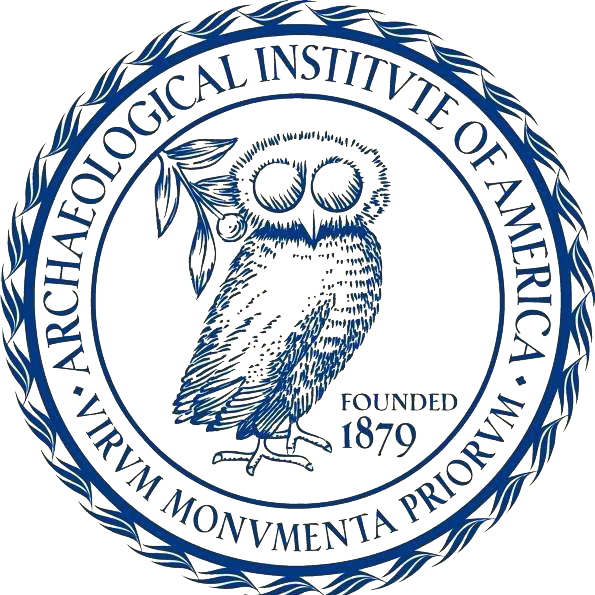
AIA MEMBERSHIP
Join the Archaeological Institute of America, the world’s largest and oldest archaeological organization today, and be connected with thousands of other members who share your passion for archaeology!
Connect with thousands of members who share your passion for archaeology.
Participate in local events through an AIA Local Society.
Receive exclusive MEMBER BENEFITS.
Members like you support excavation, preservation, outreach, education, advocacy, and the professional activities of the AIA.
RECENT ARCHAEOLOGY NEWS
3,000-Year-Old Maya Urban Center Identified in Guatemala
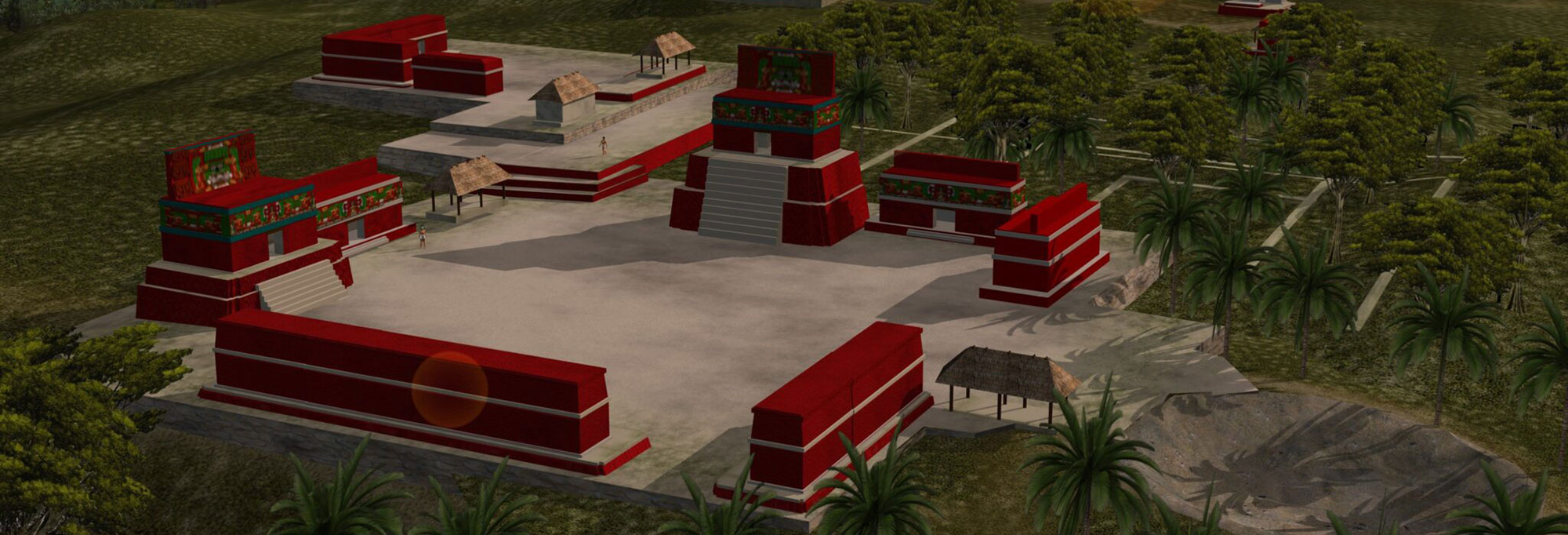 UAXACTÚN, GUATEMALA—CNN Science reports that an international team of archaeologists discovered a nearly 3,000-year-old Maya city in Guatemala’s Petén region, around 13 miles northeast of the famous site of Uaxactún. The urban complex is actually spread across six miles and three sites: Los Abuelos, Petnal, and Cambrayal. Dating to between 800 and 500 b.c., these sites form one of the oldest and most prominent Maya ceremonial centers ever found. Los Abuelos, which means “grandparents” in Spanish, takes its name from a pair of human-like sculptures uncovered at the site that are believed to be associated with ancestor worship rituals. In Petnal, archaeologists identified a 108-foot-tall pyramid adorned with painted murals, while at Cambrayal they located a palace containing a sophisticated network of canals. Guatemala’s Ministry of Culture and Sports stated that the sites form a previously unknown urban triangle that is not only a testament to the greatness of the Maya but is also leading to a new understanding of early Maya history. To read about murals found in Guatemala's western highlands that depict performances combining both Indigenous and colonial traditions, go to "Dancing Days of the Maya."
UAXACTÚN, GUATEMALA—CNN Science reports that an international team of archaeologists discovered a nearly 3,000-year-old Maya city in Guatemala’s Petén region, around 13 miles northeast of the famous site of Uaxactún. The urban complex is actually spread across six miles and three sites: Los Abuelos, Petnal, and Cambrayal. Dating to between 800 and 500 b.c., these sites form one of the oldest and most prominent Maya ceremonial centers ever found. Los Abuelos, which means “grandparents” in Spanish, takes its name from a pair of human-like sculptures uncovered at the site that are believed to be associated with ancestor worship rituals. In Petnal, archaeologists identified a 108-foot-tall pyramid adorned with painted murals, while at Cambrayal they located a palace containing a sophisticated network of canals. Guatemala’s Ministry of Culture and Sports stated that the sites form a previously unknown urban triangle that is not only a testament to the greatness of the Maya but is also leading to a new understanding of early Maya history. To read about murals found in Guatemala's western highlands that depict performances combining both Indigenous and colonial traditions, go to "Dancing Days of the Maya."
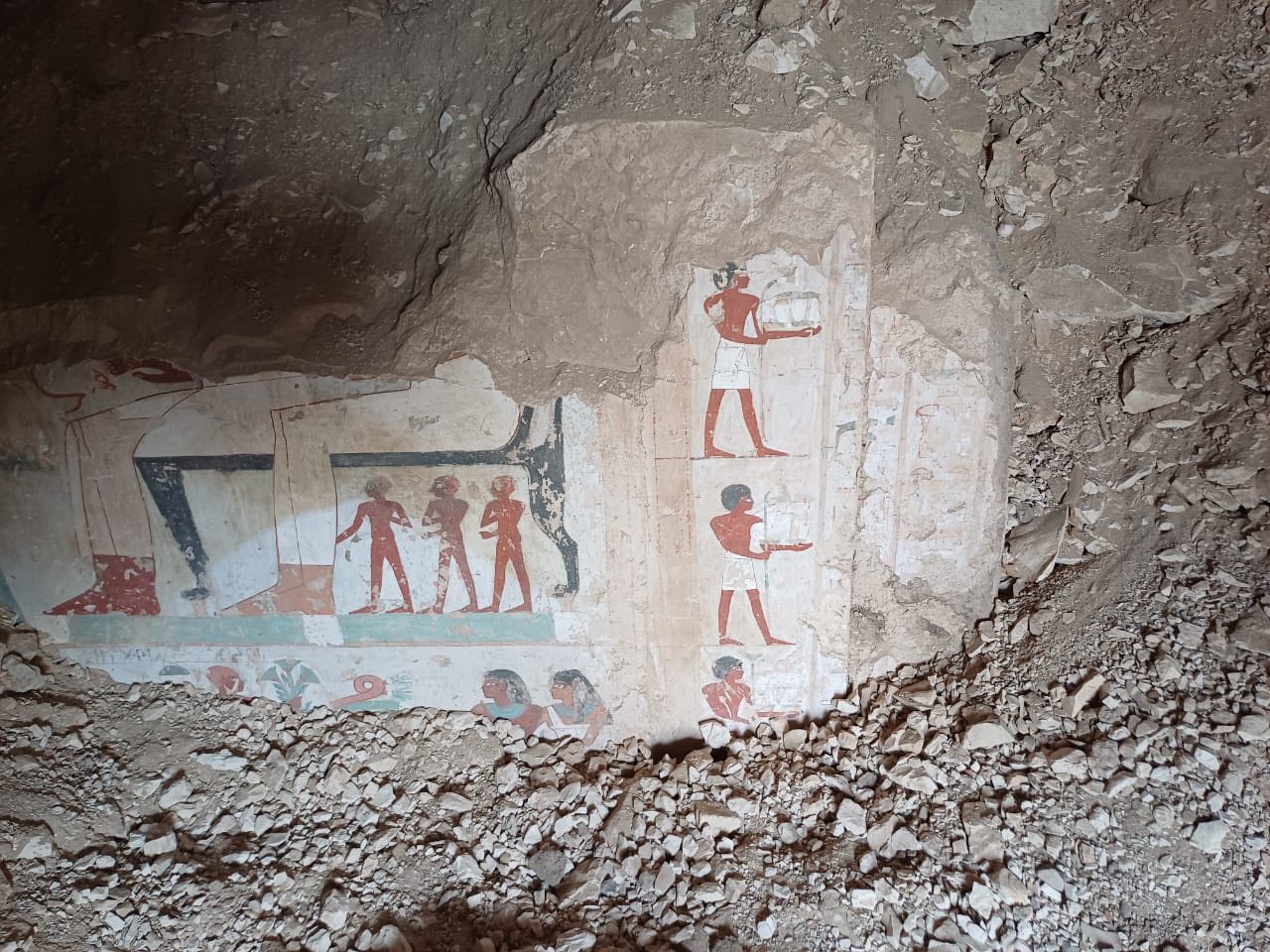 Tombs of Three Ancient Egyptian Officials Found in Luxor
Tombs of Three Ancient Egyptian Officials Found in Luxor
LUXOR, EGYPT—Three new tombs of senior ancient Egyptian statesmen were recently unearthed on Luxor’s West Bank, according to an Ahram Online report. The discoveries were made at the New Kingdom necropolis of Dra Abu el-Nagra and have provided new insights into the lives of officials who worked in the upper echelon of Egyptian government. Archaeologists learned the men’s names and titles from inscriptions written on the walls of the burial chambers. One tomb belonged to a man named Amun-em-Ipet, who worked at a temple or estate dedicated to the god Amun during the Ramesside period (ca. 1295–1070 b.c.). The other two date to the 18th Dynasty (ca. 1550–1295 b.c.). One contained the burial of a man named Baki, who was a granary supervisor, while the other, an individual called Es, had earned multiple titles including supervisor of the Temple of Amun, mayor of the northern oases, and scribe. Minister of Tourism and Antiquities Sherif Fathy said that the newly discovered burial chambers were windows into the lives, roles, and beliefs of key figures in ancient Egyptian society. To read about the grave of another high-level Egyptian official uncovered at the site, go to "Afterlife of a Dignitary."
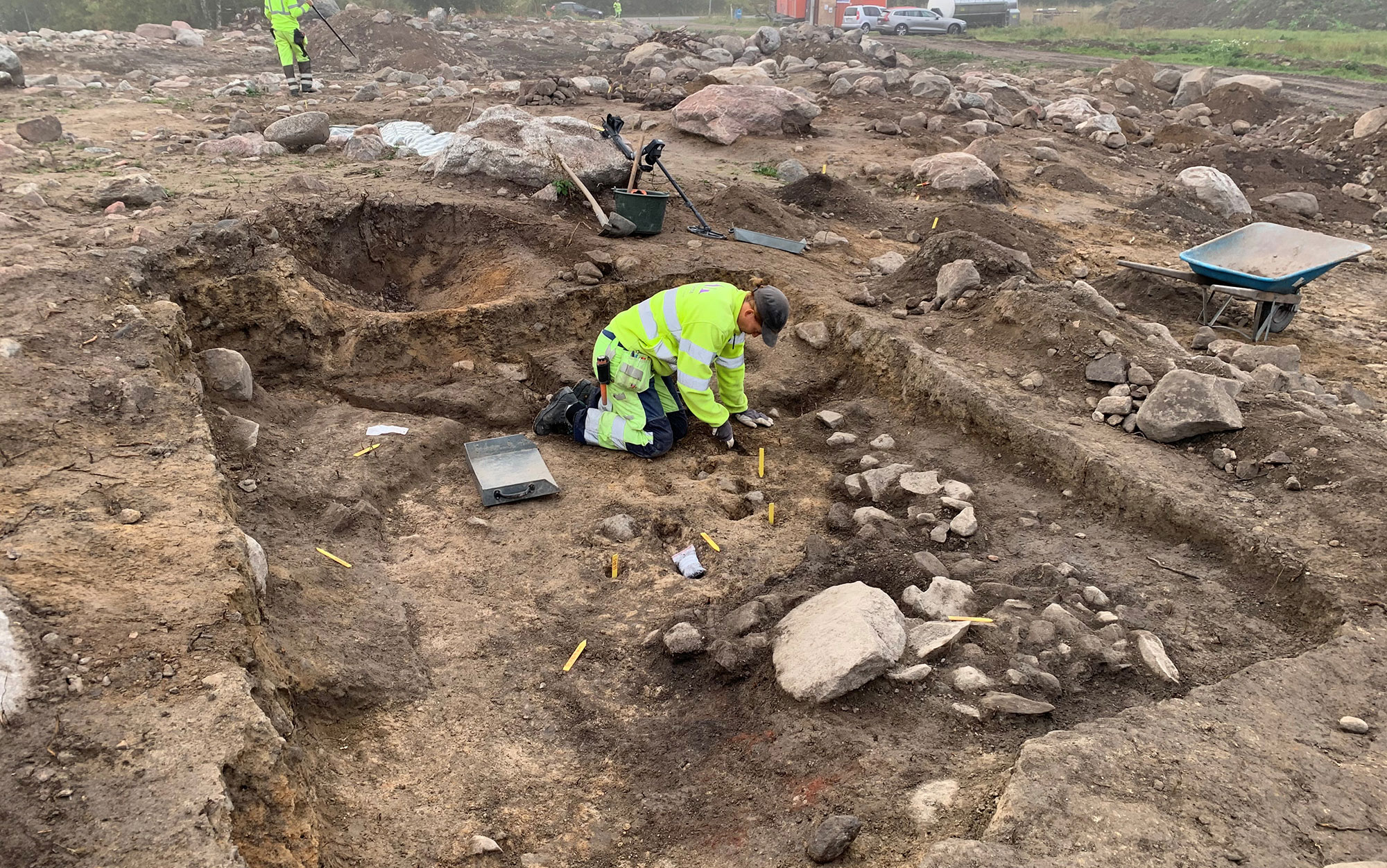 Viking Age Silver Treasure Uncovered Near Stockholm
Viking Age Silver Treasure Uncovered Near Stockholm
TÄBY, SWEDEN—Sweden’s Arkeologerna announced that archaeologists working in Viggbyholm, Täby, outside of Stockholm, unearthed a stunning 1,000-year-old Viking Age treasure trove. The site was inhabited from around a.d. 400 to 1050 and contains more than 20 houses and other buildings. Beneath the flooring of one structure, former occupants concealed an array of valuables they were never able to retrieve, for reasons that are still unknown. The collection includes eight silver neck torcs, two silver armbands, one ring, two pearls, and 12 coins that were turned into pendants. These had been carefully wrapped in a cloth purse and placed in a ceramic vase for safekeeping. “This is something you probably only experience once in a lifetime,” said archaeologist Maria Lingström. The diverse origins of the coins—which came from places such as England, Normandy, Bohemia, Bavaria, and even Persia—are indicative of the far-reaching trade connections that Viking Age Scandinavians developed. To read about Viking wealth found on an island off the Swedish coast, go to "Hoards of the Vikings."
CURRENT ARCHAEOLOGY MAGAZINE
Click the cover image for more details

A Passion for Fruit
Exploring the surprisingly rich archaeological record of berries, melons…and more
Lost City of the Samurai
Archaeologists rediscover Ichijodani, a formidable stronghold that flourished amid medieval Japan’s brutal power struggles
Goddess at the Crossroads
Why a city put its trust in a Greek deity feared throughout the Mediterranean world
Desert Paradise Found
How a tiny, water-rich kingdom came to dominate vital trade routes in the Arabian Gulf 4,000 years ago
Peru’s Timeless Threads
More than 1,000 years ago, master weavers kept the ancient traditions of the Moche culture alive


